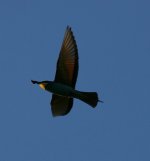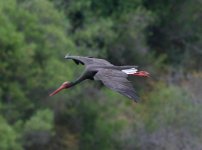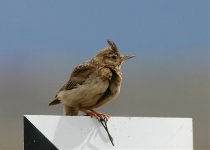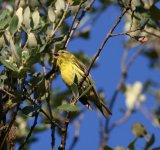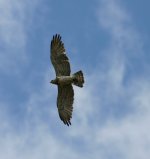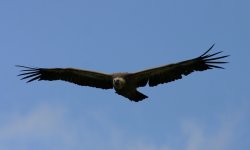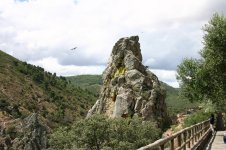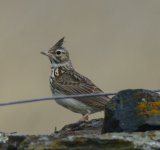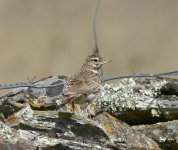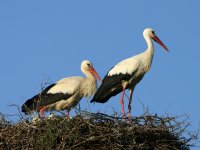MSA
I may be relaxed but I'm not drunk....
EXTREMADURA, SPAIN
16-18 June 2007
With work, family and other commitments, and non-birding spouses/partners, making pure bird-watching holidays increasingly difficult, the opening of a new budget airline route from our local airport to Madrid immediately grabbed our attention as offering the potential for a short break to a birding Mecca. Despite Ryanair’s last-minute change of flight times chopping 4 hours off the first day, and possibly the worst June weather on record, we had a very successful trip, with all the target species seen, bar one, and at a very reasonable cost.
Sat 16 June
We arrived at Madrid at around 15:30, ahead of schedule after a flight of just under two hours, and breezed through immigration and baggage with no problems. Our Hertz hire car was ready and waiting, so off we went, negotiating the Madrid ring road system with relative ease and headed off along the A5 towards Trujillo.
The weather was against us from the start, but we still managed a few birds from the car, including the first local speciality, Azure-winged Magpie. Corn Bunting and Spotless Starling were also noted, with the latter having a decidedly different “jizz” to European Starling. Eventually the weather broke, and we stopped at an area of lagoons/marsh at Almarez. Here we found most of the usual inhabitants of such an area, including Fan-tailed Warbler, Cattle Egret, Purple Heron, Night Heron, Little Bittern, Savi’s and Great Reed Warbler, Gull-billed Tern, Purple Gallinule and Bee-eater. Also seen were Spanish Sparrow, Red-rumped Swallow, Marsh Harrier, Black Kite and White Stork.
Hoping to arrive at our accommodation in daylight we headed off after an hour or so towards Trujillo. More Azure-winged Magpie were seen en-route, as well as Woodchat, Little Owl, Serin, Turtle Dove, Bee-eater, Great Spotted Cuckoo, Lesser Kestrel, Crag Martin and Hoopoe. The accommodation was superb, but unfortunately there was a large party arriving so we had to go to Trujillo for food – an interesting little town, with nesting White Stork, Lesser Kestrel and Crag Martin. A rather overpriced meal ensued, but the wine was very nice! A wet walk back to the car was less welcome. The evening was concluded with a note-writing session at the Finca, with the rain still falling around us.
Sun 17 June
Dawn broke to heavy rain, so breakfast was taken at the Finca before venturing into the field. Rain-sodden Azure-winged Magpie were not so reticent, being seen on the lawn a few feet from our rooms.
Our first stop (or to be more precise, series of stops) was the Belen Plains area. Good numbers of locally-common birds were seen, including 7 Little Owl, 10 Woodchat Shrike, 4 Great Grey Shrike, Hoopoe and Black Kite. Several large flocks of Calandra Lark were also seen, with maybe 400+ birds involved, and a huge flock of Cattle Egret suggested over 500 birds present. A minimum of 4 male Great Bustard were seen at separate sites, with female Montagu’s Harrier, Fan-tailed Warbler, 2 Raven, Short-toed and Booted Eagle, Green Sandpiper, Egyptian Vulture and 3 Black Vulture also noted. It was also nice to be surrounded by birds that would be really special in the UK, such as White Stork, Red-rumped Swallow, Fan-tailed Warbler and Crested Lark.
Our next destination was Monfrague, where we were met by a flurry of raptors amongst which were two that initially caused confusion, but were eventually pinned down to being young Short-toed Eagle in amongst a host of Black and Griffon Vulture, with the latter in particular being ever-present throughout the region. Crag Martin and Bee-eater were also present in fair numbers. Several stops were made en-route and at one stop, by a small bridge, a single White-rumped Swift gave good, if rather brief, views as it fed alongside a House Martin and other hirundines.
Arriving at the Castillo de Monfrague via a short but rather steep footpath, we spent the next hour or so scanning the skies for raptors and swifts. The weather had improved by now, and we were in danger of sunburn! Many Alpine and Pallid Swift were noted amongst the Common Swift, and other birds around the hillside included Serin, Golden Oriole, Sardinian Warbler, Nuthatch, Blue Rock Thrush, Egyptian Vulture and a single soaring Black Stork, as well as maybe 400 Griffon Vulture, some individuals seen stunningly well as they soared around their cliffside nests. The highlight was a group of three Bonelli’s Eagle; initially two birds were seen approaching from some considerable distance, but as they drew closer their identity was confirmed, and they displayed for a while before being joined by a third bird.
A short drive found us at Pena Falcon, where even closer Griffon Vultures were wheeling overhead. Rock Bunting sang from the rock face, Black Redstart, Blue Rock Thrush and Subalpine Warbler were in the surrounding scrub and cliffs, and a Black Stork made a couple of passes along the river before landing on its nest on the opposite cliff face.
After stopping for a welcome snack at the visitor centre, our final stop within Monfrague was at Tietar, where the rock face opposite the hide was scoured for Eagle Owl, with no success. However, the site did produce Nightingale, Sardinian Warbler, Turtle Dove, Rock Bunting and Blue Rock Thrush.
One of our “target species” for the trip was Red-necked Nightjar, and it was thought that this evening would be our only real chance to find this species, so we dashed back from Monfrague to the Finca, where we had been told the nightjar could be found on the nearby hillside. A quick stop en-route produced Great Reed Warbler and 40 Bee-eater, and Red-legged Partridge was seen from the car, but our goal of arriving back in daylight was achieved, and we headed up the hill on the only track. Unfortunately the track ended at a farmhouse – a mass trespass across a field followed, only to be thwarted by a high wall topped by fencing. Various options were discussed (mostly illegal) but good fortune followed, as a distant calling bird was followed by a closer bird, back in the direction of the Finca. Sharp eyes picked out a movement near the top of a dead tree, and soon all four of us were watching a singing Red-necked Nightjar! The bird occasionally flew around the treetops, and was joined by a second bird, both giving as good a view as could be expected of a crepuscular species. Returning to our accommodation we realised that the dead tree was visible from the car park, so we played a CD recording and a nightjar responded almost immediately. Rather too many celebratory drinks under the veranda followed.
Mon 18 June
Awaking with a start, somewhat later than our final day deserved, a pre-breakfast stroll around the grounds produced a few new birds for the trip, including Quail, Short-toed Treecreeper (sounding very similar to Coal Tit), Hawfinch and Cirl Bunting alongside the regular Golden Oriole, Bee-eater, Serin and Woodchat. Breakfast taken, bills settled and bags packed, we headed out towards Santa Marta, west of Trujillo. An odd raptor seen from the car prompted our first stop, and Golden Eagle was added to the trip-list with a rather distant view; Lapwing, Bee-eater, Southern Grey Shrike, Short-toed Lark, Common Buzzard, Raven, Red Kite and 20+ Calandra Lark were also seen here, as well as Thekla Lark (only positively ID’d upon examination of photographs after returning home). Thousands of large insects, maybe locusts, were also seen around the path through the fields. Continuing on the same road, Booted Eagle overflew the car. A most welcome lunch was taken in a small bar/café in Santa Marta.
Leaving Santa Marta towards Monroy, a stop at a road junction proved to be very productive, with Montagu’s Harrier (including a territorial female close to the car), 2 Bonelli’s Eagle, 3 Booted Eagle, Egyptian Vulture and another Red Kite.
Following a tip from the old guidebook for the area, “Muddeman”, we stopped in a river valley at Rio Almonte, where Crag Martin were nesting under the road bridge, Short-toed Eagle flew low overhead, and Blue Rock Thrush, Golden Oriole and Stonechat were also noted. Eventually an unfamiliar call was heard, and a Black Wheatear was picked out on the rockface, showing well but rather distantly as it flew around from perch to perch.
Leaving Monroy on the Ex 390, a stop near Torrijan (El Rubio) had been suggested for Black-shouldered Kite, but apart from a few Raven and Woodchat Shrike, nothing else was obvious in the area. However, perseverance finally paid off, as two Spanish Imperial Eagle were picked out amongst the wheeling hordes of Griffon Vulture, with one of the birds landing on a distant pylon.
A return visit to the Castillo produced Hawfinch, Sparrowhawk, Alpine Swift, Rock Bunting, Black Redstart and most of the birds seen on our last visit, with a Green Lizard at the White-rumped Swift site, and Black and Red Kite, plus Booted Eagle, at the Monfrague Information Centre, where we once again stopped for a bocadillo.
Our final destination was the rockface at Tietar. A cursory scan revealed nothing of note, so we searched the surrounding area and found Rock Bunting, several Nightingale, Sardinian Warbler, Cuckoo, Golden Oriole, Turtle Dove, Booted Eagle, Kestrel, Hawfinch (several flocks passing along the valley), Blue Rock Thrush, ST Treecreeper, LT Tit, Red-legged Partridge, Black Stork etc. After an hour or so, a local couple arrived, and almost immediately the chap said “bubo”… we tried to explain that was what we were looking for, but he was quite insistent, and we eventually realised that he had found the owl – an adult Eagle Owl near the top of the cliff! More scanning revealed a juvenile close by, and both birds were eventually seen in flight. Remarkably, a few minutes later the same chap called “aquila” and a superb Spanish Imperial Eagle drifted overhead! Several Scops Owl were calling nearby; rather more interestingly, many of the overhead Swift were eventually identified as White-rumped Swift. As dusk approached, Nightjar appeared, with a couple of close birds tentatively identified as Red-necked, confirmed as they responded to the CD. An overnight drive to the airport followed, for an early morning flight home.
Trip list:
Little Grebe Tachybaptus ruficollis
Great Cormorant Phalacrocorax carbo
Grey Heron Ardea cinerea cinerea
Purple Heron Ardea purpurea purpurea
Little Egret Egretta garzetta garzetta
Cattle Egret Bubulcus ibis ibis
Black-crowned Night-Heron Nycticorax nycticorax nycticorax
Little Bittern Ixobrychus minutus minutus
Black Stork Ciconia nigra
White Stork Ciconia ciconia
Eurasian Spoonbill Platalea leucorodia leucorodia
Mallard Anas platyrhynchos platyrhynchos
Red Kite Milvus milvus
Black Kite Milvus migrans migrans
Eurasian Griffon Vulture Gyps fulvus fulvus
Black Vulture Aegypius monachus
Short-toed Eagle Circaetus gallicus gallicus
Montagu's Harrier Circus pygargus
Eurasian Marsh-Harrier Circus aeruginosus aeruginosus
Eurasian Sparrowhawk Accipiter nisus nisus
Common Buzzard Buteo buteo
Spanish Imperial Eagle Aquila adalberti
Golden Eagle Aquila chrysaetos
Bonelli's Eagle Aquila fasciatus fasciatus
Booted Eagle Aquila pennatus pennatus
Lesser Kestrel Falco naummani
Eurasian Kestrel Falco tinnunculus tinnunculus
Red-legged Partridge Alectoris rufa
Common Quail Coturnix coturnix
Purple Swamphen Porphyrio porphyrio porphyrio
Common Moorhen Gallinula chloropus chloropus
Common or Eurasian Coot Fulica atra atra
Great Bustard Otis tarda tarda
Northern Lapwing Vanellus vanellus
Green Sandpiper Tringa ochropus
Gull-billed Tern Gelochelidon nilotica nilotica
Common Tern Sterna hirundo hirundo
Feral Pigeon Columba livia feral (introduced)
Rock Dove Columba livia livia
Common Wood-Pigeon Columba palumbus palumbus
European Turtle-Dove Streptopelia turtur turtur
Eurasian Collared-Dove Streptopelia decaocto decaocto
Great Spotted Cuckoo Clamator glandarius
Eurasian Cuckoo Cuculus canorus
Eurasian Scops-Owl Otus scops
Eurasian Eagle-Owl Bubo bubo
Little Owl Athene noctua vidalii
Red-necked Nightjar Caprimulgus ruficollis ruficollis
Alpine Swift Tachymarptis melba melba
Common Swift Apus apus apus
Pallid Swift Apus pallidus brehmorum
White-rumped Swift Apus caffer
Eurasian Hoopoe Upupa epops epops
Common Kingfisher Alcedo atthis
European Bee-eater Merops apiaster
Eurasian Wryneck Jynx torquilla torquilla
Greater Short-toed Lark Calandrella brachydactyla brachydactyla
Crested Lark Galerida cristata
Thekla Lark Galerida theklae theklae
Calandra Lark Melanocorypha calandra calandra
Eurasian Crag-Martin Ptyonoprogne rupestris
Barn Swallow Hirundo rustica rustica
Red-rumped Swallow Cecropis daurica rufula
Northern House-Martin Delichon urbicum urbicum
White Wagtail Motacilla alba alba
Winter Wren Troglodytes troglodytes
Common Nightingale Luscinia megarhynchos
European Robin Erithacus rubecula
Black Redstart Phoenicurus ochruros
European Stonechat Saxicola rubicola
Black Wheatear Oenanthe leucura leucura
Northern Wheatear Oenanthe oenanthe
Blue Rock-Thrush Monticola solitarius solitarius
Eurasian Blackbird Turdus merula merula
Mistle Thrush Turdus viscivorus viscivorus
Cetti's Warbler Cettia cetti cetti
Savi's Warbler Locustella luscinioides luscinioides
Eurasian Reed-Warbler Acrocephalus scirpaceus
Great Reed-Warbler Acrocephalus arundinaceus arundinaceus
Zitting Cisticola Cisticola juncidis cisticola
Garden Warbler Sylvia borin borin
Sardinian Warbler Sylvia melanocephala melanocephala
Subalpine Warbler Sylvia cantillans cantillans
Spectacled Warbler Sylvia conspicillata conspicillata
Eurasian Nuthatch Sitta europaea caesia
Short-toed Treecreeper Certhia brachydactyla
Eurasian Blue Tit Cyanistes caeruleus
Great Tit Parus major
Long-tailed Tit Aegithalos caudatus
Southern Grey Shrike Lanius meridionalis
Woodchat Shrike Lanius senator
Eurasian Jay Garrulus glandarius
Azure-winged Magpie Cyanopica cooki
Eurasian Magpie Pica pica melanotos
Eurasian Jackdaw Corvus monedula
Carrion Crow Corvus corone corone
Common Raven Corvus corax
Spotless Starling Sturnus unicolor
Eurasian Golden-Oriole Oriolus oriolus
Chaffinch Fringilla coelebs
European Serin Serinus serinus
European Greenfinch Carduelis chloris
European Goldfinch Carduelis carduelis
Eurasian Linnet Carduelis cannabina
Hawfinch Coccothraustes coccothraustes coccothraustes
House Sparrow Passer domesticus domesticus
Spanish Sparrow Passer hispaniolensis hispaniolensis
Cirl Bunting Emberiza cirlus cirlus
Rock Bunting Emberiza cia
Corn Bunting Emberiza calandra calandra
(110 Species)
Participants:
Mark Andrews
Chris Chapleo
Roger Howell
Trevor Warrick
Accommodation:
http://www.fincasantamarta.com/
16-18 June 2007
With work, family and other commitments, and non-birding spouses/partners, making pure bird-watching holidays increasingly difficult, the opening of a new budget airline route from our local airport to Madrid immediately grabbed our attention as offering the potential for a short break to a birding Mecca. Despite Ryanair’s last-minute change of flight times chopping 4 hours off the first day, and possibly the worst June weather on record, we had a very successful trip, with all the target species seen, bar one, and at a very reasonable cost.
Sat 16 June
We arrived at Madrid at around 15:30, ahead of schedule after a flight of just under two hours, and breezed through immigration and baggage with no problems. Our Hertz hire car was ready and waiting, so off we went, negotiating the Madrid ring road system with relative ease and headed off along the A5 towards Trujillo.
The weather was against us from the start, but we still managed a few birds from the car, including the first local speciality, Azure-winged Magpie. Corn Bunting and Spotless Starling were also noted, with the latter having a decidedly different “jizz” to European Starling. Eventually the weather broke, and we stopped at an area of lagoons/marsh at Almarez. Here we found most of the usual inhabitants of such an area, including Fan-tailed Warbler, Cattle Egret, Purple Heron, Night Heron, Little Bittern, Savi’s and Great Reed Warbler, Gull-billed Tern, Purple Gallinule and Bee-eater. Also seen were Spanish Sparrow, Red-rumped Swallow, Marsh Harrier, Black Kite and White Stork.
Hoping to arrive at our accommodation in daylight we headed off after an hour or so towards Trujillo. More Azure-winged Magpie were seen en-route, as well as Woodchat, Little Owl, Serin, Turtle Dove, Bee-eater, Great Spotted Cuckoo, Lesser Kestrel, Crag Martin and Hoopoe. The accommodation was superb, but unfortunately there was a large party arriving so we had to go to Trujillo for food – an interesting little town, with nesting White Stork, Lesser Kestrel and Crag Martin. A rather overpriced meal ensued, but the wine was very nice! A wet walk back to the car was less welcome. The evening was concluded with a note-writing session at the Finca, with the rain still falling around us.
Sun 17 June
Dawn broke to heavy rain, so breakfast was taken at the Finca before venturing into the field. Rain-sodden Azure-winged Magpie were not so reticent, being seen on the lawn a few feet from our rooms.
Our first stop (or to be more precise, series of stops) was the Belen Plains area. Good numbers of locally-common birds were seen, including 7 Little Owl, 10 Woodchat Shrike, 4 Great Grey Shrike, Hoopoe and Black Kite. Several large flocks of Calandra Lark were also seen, with maybe 400+ birds involved, and a huge flock of Cattle Egret suggested over 500 birds present. A minimum of 4 male Great Bustard were seen at separate sites, with female Montagu’s Harrier, Fan-tailed Warbler, 2 Raven, Short-toed and Booted Eagle, Green Sandpiper, Egyptian Vulture and 3 Black Vulture also noted. It was also nice to be surrounded by birds that would be really special in the UK, such as White Stork, Red-rumped Swallow, Fan-tailed Warbler and Crested Lark.
Our next destination was Monfrague, where we were met by a flurry of raptors amongst which were two that initially caused confusion, but were eventually pinned down to being young Short-toed Eagle in amongst a host of Black and Griffon Vulture, with the latter in particular being ever-present throughout the region. Crag Martin and Bee-eater were also present in fair numbers. Several stops were made en-route and at one stop, by a small bridge, a single White-rumped Swift gave good, if rather brief, views as it fed alongside a House Martin and other hirundines.
Arriving at the Castillo de Monfrague via a short but rather steep footpath, we spent the next hour or so scanning the skies for raptors and swifts. The weather had improved by now, and we were in danger of sunburn! Many Alpine and Pallid Swift were noted amongst the Common Swift, and other birds around the hillside included Serin, Golden Oriole, Sardinian Warbler, Nuthatch, Blue Rock Thrush, Egyptian Vulture and a single soaring Black Stork, as well as maybe 400 Griffon Vulture, some individuals seen stunningly well as they soared around their cliffside nests. The highlight was a group of three Bonelli’s Eagle; initially two birds were seen approaching from some considerable distance, but as they drew closer their identity was confirmed, and they displayed for a while before being joined by a third bird.
A short drive found us at Pena Falcon, where even closer Griffon Vultures were wheeling overhead. Rock Bunting sang from the rock face, Black Redstart, Blue Rock Thrush and Subalpine Warbler were in the surrounding scrub and cliffs, and a Black Stork made a couple of passes along the river before landing on its nest on the opposite cliff face.
After stopping for a welcome snack at the visitor centre, our final stop within Monfrague was at Tietar, where the rock face opposite the hide was scoured for Eagle Owl, with no success. However, the site did produce Nightingale, Sardinian Warbler, Turtle Dove, Rock Bunting and Blue Rock Thrush.
One of our “target species” for the trip was Red-necked Nightjar, and it was thought that this evening would be our only real chance to find this species, so we dashed back from Monfrague to the Finca, where we had been told the nightjar could be found on the nearby hillside. A quick stop en-route produced Great Reed Warbler and 40 Bee-eater, and Red-legged Partridge was seen from the car, but our goal of arriving back in daylight was achieved, and we headed up the hill on the only track. Unfortunately the track ended at a farmhouse – a mass trespass across a field followed, only to be thwarted by a high wall topped by fencing. Various options were discussed (mostly illegal) but good fortune followed, as a distant calling bird was followed by a closer bird, back in the direction of the Finca. Sharp eyes picked out a movement near the top of a dead tree, and soon all four of us were watching a singing Red-necked Nightjar! The bird occasionally flew around the treetops, and was joined by a second bird, both giving as good a view as could be expected of a crepuscular species. Returning to our accommodation we realised that the dead tree was visible from the car park, so we played a CD recording and a nightjar responded almost immediately. Rather too many celebratory drinks under the veranda followed.
Mon 18 June
Awaking with a start, somewhat later than our final day deserved, a pre-breakfast stroll around the grounds produced a few new birds for the trip, including Quail, Short-toed Treecreeper (sounding very similar to Coal Tit), Hawfinch and Cirl Bunting alongside the regular Golden Oriole, Bee-eater, Serin and Woodchat. Breakfast taken, bills settled and bags packed, we headed out towards Santa Marta, west of Trujillo. An odd raptor seen from the car prompted our first stop, and Golden Eagle was added to the trip-list with a rather distant view; Lapwing, Bee-eater, Southern Grey Shrike, Short-toed Lark, Common Buzzard, Raven, Red Kite and 20+ Calandra Lark were also seen here, as well as Thekla Lark (only positively ID’d upon examination of photographs after returning home). Thousands of large insects, maybe locusts, were also seen around the path through the fields. Continuing on the same road, Booted Eagle overflew the car. A most welcome lunch was taken in a small bar/café in Santa Marta.
Leaving Santa Marta towards Monroy, a stop at a road junction proved to be very productive, with Montagu’s Harrier (including a territorial female close to the car), 2 Bonelli’s Eagle, 3 Booted Eagle, Egyptian Vulture and another Red Kite.
Following a tip from the old guidebook for the area, “Muddeman”, we stopped in a river valley at Rio Almonte, where Crag Martin were nesting under the road bridge, Short-toed Eagle flew low overhead, and Blue Rock Thrush, Golden Oriole and Stonechat were also noted. Eventually an unfamiliar call was heard, and a Black Wheatear was picked out on the rockface, showing well but rather distantly as it flew around from perch to perch.
Leaving Monroy on the Ex 390, a stop near Torrijan (El Rubio) had been suggested for Black-shouldered Kite, but apart from a few Raven and Woodchat Shrike, nothing else was obvious in the area. However, perseverance finally paid off, as two Spanish Imperial Eagle were picked out amongst the wheeling hordes of Griffon Vulture, with one of the birds landing on a distant pylon.
A return visit to the Castillo produced Hawfinch, Sparrowhawk, Alpine Swift, Rock Bunting, Black Redstart and most of the birds seen on our last visit, with a Green Lizard at the White-rumped Swift site, and Black and Red Kite, plus Booted Eagle, at the Monfrague Information Centre, where we once again stopped for a bocadillo.
Our final destination was the rockface at Tietar. A cursory scan revealed nothing of note, so we searched the surrounding area and found Rock Bunting, several Nightingale, Sardinian Warbler, Cuckoo, Golden Oriole, Turtle Dove, Booted Eagle, Kestrel, Hawfinch (several flocks passing along the valley), Blue Rock Thrush, ST Treecreeper, LT Tit, Red-legged Partridge, Black Stork etc. After an hour or so, a local couple arrived, and almost immediately the chap said “bubo”… we tried to explain that was what we were looking for, but he was quite insistent, and we eventually realised that he had found the owl – an adult Eagle Owl near the top of the cliff! More scanning revealed a juvenile close by, and both birds were eventually seen in flight. Remarkably, a few minutes later the same chap called “aquila” and a superb Spanish Imperial Eagle drifted overhead! Several Scops Owl were calling nearby; rather more interestingly, many of the overhead Swift were eventually identified as White-rumped Swift. As dusk approached, Nightjar appeared, with a couple of close birds tentatively identified as Red-necked, confirmed as they responded to the CD. An overnight drive to the airport followed, for an early morning flight home.
Trip list:
Little Grebe Tachybaptus ruficollis
Great Cormorant Phalacrocorax carbo
Grey Heron Ardea cinerea cinerea
Purple Heron Ardea purpurea purpurea
Little Egret Egretta garzetta garzetta
Cattle Egret Bubulcus ibis ibis
Black-crowned Night-Heron Nycticorax nycticorax nycticorax
Little Bittern Ixobrychus minutus minutus
Black Stork Ciconia nigra
White Stork Ciconia ciconia
Eurasian Spoonbill Platalea leucorodia leucorodia
Mallard Anas platyrhynchos platyrhynchos
Red Kite Milvus milvus
Black Kite Milvus migrans migrans
Eurasian Griffon Vulture Gyps fulvus fulvus
Black Vulture Aegypius monachus
Short-toed Eagle Circaetus gallicus gallicus
Montagu's Harrier Circus pygargus
Eurasian Marsh-Harrier Circus aeruginosus aeruginosus
Eurasian Sparrowhawk Accipiter nisus nisus
Common Buzzard Buteo buteo
Spanish Imperial Eagle Aquila adalberti
Golden Eagle Aquila chrysaetos
Bonelli's Eagle Aquila fasciatus fasciatus
Booted Eagle Aquila pennatus pennatus
Lesser Kestrel Falco naummani
Eurasian Kestrel Falco tinnunculus tinnunculus
Red-legged Partridge Alectoris rufa
Common Quail Coturnix coturnix
Purple Swamphen Porphyrio porphyrio porphyrio
Common Moorhen Gallinula chloropus chloropus
Common or Eurasian Coot Fulica atra atra
Great Bustard Otis tarda tarda
Northern Lapwing Vanellus vanellus
Green Sandpiper Tringa ochropus
Gull-billed Tern Gelochelidon nilotica nilotica
Common Tern Sterna hirundo hirundo
Feral Pigeon Columba livia feral (introduced)
Rock Dove Columba livia livia
Common Wood-Pigeon Columba palumbus palumbus
European Turtle-Dove Streptopelia turtur turtur
Eurasian Collared-Dove Streptopelia decaocto decaocto
Great Spotted Cuckoo Clamator glandarius
Eurasian Cuckoo Cuculus canorus
Eurasian Scops-Owl Otus scops
Eurasian Eagle-Owl Bubo bubo
Little Owl Athene noctua vidalii
Red-necked Nightjar Caprimulgus ruficollis ruficollis
Alpine Swift Tachymarptis melba melba
Common Swift Apus apus apus
Pallid Swift Apus pallidus brehmorum
White-rumped Swift Apus caffer
Eurasian Hoopoe Upupa epops epops
Common Kingfisher Alcedo atthis
European Bee-eater Merops apiaster
Eurasian Wryneck Jynx torquilla torquilla
Greater Short-toed Lark Calandrella brachydactyla brachydactyla
Crested Lark Galerida cristata
Thekla Lark Galerida theklae theklae
Calandra Lark Melanocorypha calandra calandra
Eurasian Crag-Martin Ptyonoprogne rupestris
Barn Swallow Hirundo rustica rustica
Red-rumped Swallow Cecropis daurica rufula
Northern House-Martin Delichon urbicum urbicum
White Wagtail Motacilla alba alba
Winter Wren Troglodytes troglodytes
Common Nightingale Luscinia megarhynchos
European Robin Erithacus rubecula
Black Redstart Phoenicurus ochruros
European Stonechat Saxicola rubicola
Black Wheatear Oenanthe leucura leucura
Northern Wheatear Oenanthe oenanthe
Blue Rock-Thrush Monticola solitarius solitarius
Eurasian Blackbird Turdus merula merula
Mistle Thrush Turdus viscivorus viscivorus
Cetti's Warbler Cettia cetti cetti
Savi's Warbler Locustella luscinioides luscinioides
Eurasian Reed-Warbler Acrocephalus scirpaceus
Great Reed-Warbler Acrocephalus arundinaceus arundinaceus
Zitting Cisticola Cisticola juncidis cisticola
Garden Warbler Sylvia borin borin
Sardinian Warbler Sylvia melanocephala melanocephala
Subalpine Warbler Sylvia cantillans cantillans
Spectacled Warbler Sylvia conspicillata conspicillata
Eurasian Nuthatch Sitta europaea caesia
Short-toed Treecreeper Certhia brachydactyla
Eurasian Blue Tit Cyanistes caeruleus
Great Tit Parus major
Long-tailed Tit Aegithalos caudatus
Southern Grey Shrike Lanius meridionalis
Woodchat Shrike Lanius senator
Eurasian Jay Garrulus glandarius
Azure-winged Magpie Cyanopica cooki
Eurasian Magpie Pica pica melanotos
Eurasian Jackdaw Corvus monedula
Carrion Crow Corvus corone corone
Common Raven Corvus corax
Spotless Starling Sturnus unicolor
Eurasian Golden-Oriole Oriolus oriolus
Chaffinch Fringilla coelebs
European Serin Serinus serinus
European Greenfinch Carduelis chloris
European Goldfinch Carduelis carduelis
Eurasian Linnet Carduelis cannabina
Hawfinch Coccothraustes coccothraustes coccothraustes
House Sparrow Passer domesticus domesticus
Spanish Sparrow Passer hispaniolensis hispaniolensis
Cirl Bunting Emberiza cirlus cirlus
Rock Bunting Emberiza cia
Corn Bunting Emberiza calandra calandra
(110 Species)
Participants:
Mark Andrews
Chris Chapleo
Roger Howell
Trevor Warrick
Accommodation:
http://www.fincasantamarta.com/




